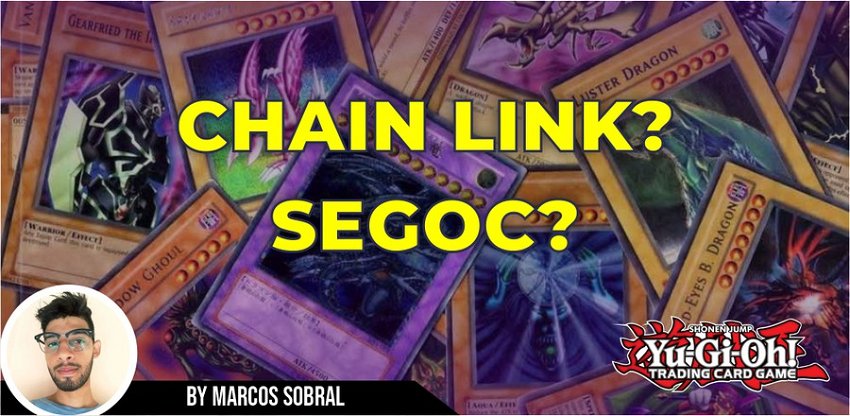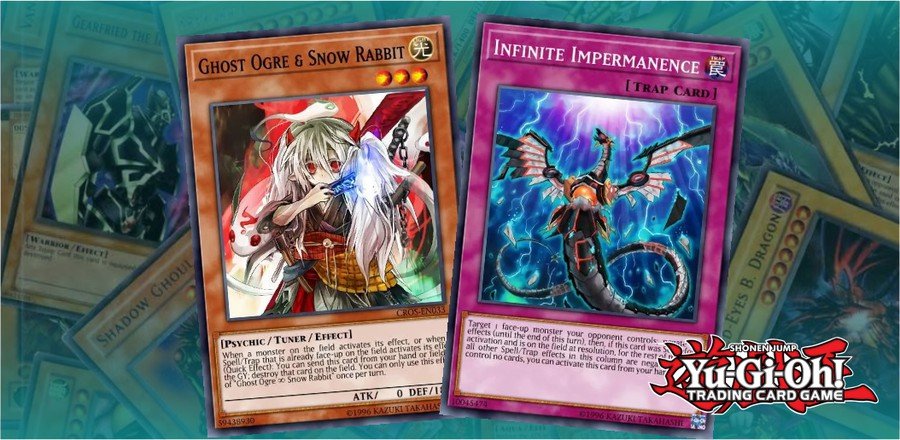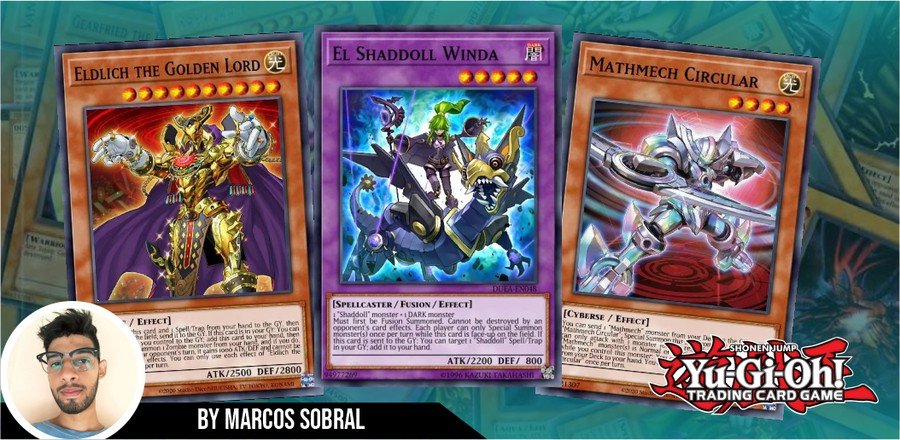Introduction
Yu-Gi-Oh has several very specific rules and interactions that end up generating a series of doubts, especially for those who are starting to play the card game. Therefore, we prepared this article in an attempt to facilitate your learning about Chain Link and SEGOC interactions.
I'll explain everything you need to know below!
What is Chain Link?
A Chain is a “pile” that determines the resolution order of cards and effects activated during a duel. Cards and effects only go in a Chain if they are activated.
Chains are formed when a card or effect is activated in response to the activation of another card or effect. Each activation is placed as a Chain Link (Chain Link), the first activation being Chain Link 1 or “Chain Link 1”. Players must follow fast effect timing rules when adding effects to the chain.
If neither player responds to the most recent Chain Link, the Chain resolves, with the Chain Links resolving in the opposite order of their activation.
Cards and effects can only be added to a Chain while it is being built, and once a Chain begins to resolve, cards and effects cannot be activated until the entire Chain is resolved.
Starting a chain
The turn player has the right to start a Chain at any time during their turn. However, this right will pass to the opponent on some occasions:
> When the player on the turn doesn't want to take any action while the game state is closed;
> When the player on the turn wants to move to the next Stage/Phase of the duel;
> When the opponent has a Flip, Trigger Effect, or Trigger-like effect that meets its activation time.
Building a Chain
The card or effect that started the Chain corresponds to Chain Link 1 or Chain Link 1. The next one will be Chain Link 2, then Chain Link 3 and so on, with each number corresponding to when it was activated in relation to the other Chain Links.
Cards and effects can only be activated as Chain Link 2 or higher if they have a spell speed equal to or greater than the previous Chain Link. Spell Speed 1 effects cannot be activated at Chain Link 2 or higher, except for Trigger and Trigger-like effects if triggered simultaneously; in this case, they must be Chained first before any player has the opportunity to activate quick effects.
New Chain Links can be activated in response to either the most recent activation (the immediately preceding Chain Link) or the card or effect to which Chain Link 1 is responding.
After putting all spell speed 1 effects into the Chain, or after any quick effect activation, the player who hasn't added the current Chain Link has the right to add a new one or pass it to their opponent. If the opponent doesn't add effects to the Chain, the Chain is complete. Cards and effects cannot be resolved until the Chain resolution ends.
Resolving a Chain
Once both players have decided not to add any more effects to the Chain, the Chain is complete. Thus, the Chain is resolved, starting from the Chain's most recent Chain Link. That is, it resolves backwards. Cards and effects cannot be activated while a Chain is resolving.
Once the entire Chain is resolved, if any of the cards have not yet been moved to another location, they will be sent to the Graveyard. This action occurs simultaneously with the last part of the last resolved Chain Link effect's resolution.
Example
Chain Link 1: Player 1 activates Raigeki.
Chain Link 2: Player 2 activates Anti Raigeki in response to "Raigeki".
Chain Link 3: Player 1 activates Solemn Judgment in response to “Anti Raigeki” by paying half their life.
Chain is resolved in reverse activation order, starting with the last Chain Link that was activated.
Chain Link 3: Solemn Judgment resolves by negating the activation of “Anti Raigeki” and destroys it.

Chain Link 2: Anti Raigeki has its activation denied, so nothing happens on this Chain Link.

Chain Link 3: The effect of Raigeki resolves, destroying all monsters Player 2 controls.

What is SEGOC?
SEGOC is short for Simultaneous Effects Go On Chain, which is a process used to handle multiple Trigger or Trigger-Like effects that reach their activation time at the same time. If this occurs, all activated Trigger and Trigger-Like effects are placed in a Chain.

For example, if Dharc the Dark Charmer, Gloomy attacks Lyna the Light Charmer, Lustrous, as they both have 1850 attack points, they will both be destroyed as a result of this battle and will reach their activation times at the same time.
This does not apply to effects that activate "During […] Phase…" or "At the end of […] Phase…", such as "Gladiator Beast" monsters. Instead, each effect activates as Chain Link 1 of its own Chain.
If a Trigger or Trigger-Like effect reaches its activation time during the activation or resolution of a Chain, its effect cannot be activated until that Chain is fully resolved. If this effect doesn't lose its activation time, it starts a new Chain immediately after the previous Chain has completely resolved. If multiple Trigger or Trigger-Like effects do this, they all form a Chain using the “SEGOC” rules.
Activation order
Trigger and Trigger-Like Effects when activated at the same time, must follow the following order in the construction of the Chain:
> Mandatory effects of the turn player;
> Mandatory effects from the other player;
> Optional turn player effects;
> Optional effects from the other player.
If a player has two effects in the same category (two mandatory effects or two optional effects), then that player decides the order in which to activate them, but always respecting the order shown above.
Example 1
Player 1 controls Babycerasaurus and Overtex Qoatlus. While Player 2 controls Sangan and Peten the Dark Clown. Player 1 activates Dark Hole to destroy all these monsters simultaneously, then the effects of the 4 monsters reach their activation times at the same time, and thus, the Chain will be built as follows:
Chain Link 1: Babycerasaurus, which is the only mandatory player effect for the turn.

Chain Link 2: Sangan, which is the other player's only mandatory effect.

Chain Link 3: Overtex Qoatlus, which is the turn player's only optional effect if they choose to activate it.

Chain Link 4: Peten the Dark Clown, which is the other player's only optional effect if they choose to activate it.

Example 2
Player 1 controls Dharc the Dark Charmer, Gloomy and declares an attack on Lyna the Light Charmer, Lustrous on opponent's control. After the damage calculation both are destroyed, the Chain will be built as follows:
Chain Link 1: Dharc the Dark Charmer, Gloomy, which is the turn player's only optional effect if they choose to activate it.

Chain Link 2: Lyna the Light Charmer, Lustrous, which is the other player's only optional effect if they choose to activate it.

Example 3
Player 1 controls Sangan and Witch of the Black Forest. While Player 2 controls Sangan and Peten the Dark Clown. Player 1 activates Dark Hole to destroy all these monsters simultaneously, then the effects of the 4 monsters reach their activation times at the same time, and thus, the Chain will be built as follows:
Chain Link 1 and Chain Link 2: The turn player has 2 mandatory effects of Sangan and Witch of the Black Forest. These effects will be Chain Links 1 and 2, the turn player decides the order in which they will activate.

Chain Link 3: Sangan, which is the other player's only mandatory effect.

Chain Link 4: Peten the Dark Clown, which is the other player's only optional effect if they choose to activate it.

SEGOC Limitation
Each player can only activate 1 Trigger effect of a monster that can Special Summon itself from their hand by Chain.
Example 1
Even if the player has Battle Fader and Ogre of the Scarlet Sorrow in hand when their opponent declares their second direct attack during a given turn, they can only activate the effect of one of these cards.

Example 2
When a face-up Beast-Type monster the player controls is destroyed and sent to the Graveyard, even if there are multiple copies of Green Baboon, Defender of the Forest in your hand and/or Graveyard, they can only activate the effect of one of them. This applies even if all copies are in the Graveyard.

Chain Blocking
The Chain rule only allows the last Chain Link to be answered, while the “SEGOC” allows players to choose the order of activation of the effect, as they have the same priority.
The “Chain blocking” consists of organizing your Chain Links in order to “protect” their most important effects, placing them in the previous Chain Links and the less important or more difficult to combat as the last one.
Example
Player 1 controls Flame Bufferlo while Player 2 has Ash Blossom & Joyous Spring in hand. Player 1 decides to use Flame Bufferlo as material for Link Summoning Salamangreat Balelynx, at which point there are two optional effects that can be activated and to “PLAY around” a possible Ash Blossom & Joyous Spring in the opponent's hand, the player must place its most important effect as Chain Link 1 and the least important as Chain Link 2.
The Chain would be constructed as follows:
Chain Link 1: Flame Bufferlo, which allows you to discard a Cyberse-Type monster and draw 2 cards.

Chain Link 2: Salamangreat Balelynx, which allows you to add Salamangreat Sanctuary from deck to hand.

So, even if Player 2 decides to activate Ash Blossom & Joyous Spring as Chain Link 3, they can only negate the effect of the most recent Chain Link, i.e. Player 1 will still resolve its most important effect, which is to discard a Cyberse monster and draw 2 cards.

Conclusion
For more tips and information about the Yu-Gi-Oh! TCG keep following our articles, Cards Realm thanks you!














— Comments 0
, Reactions 1
Be the first to comment